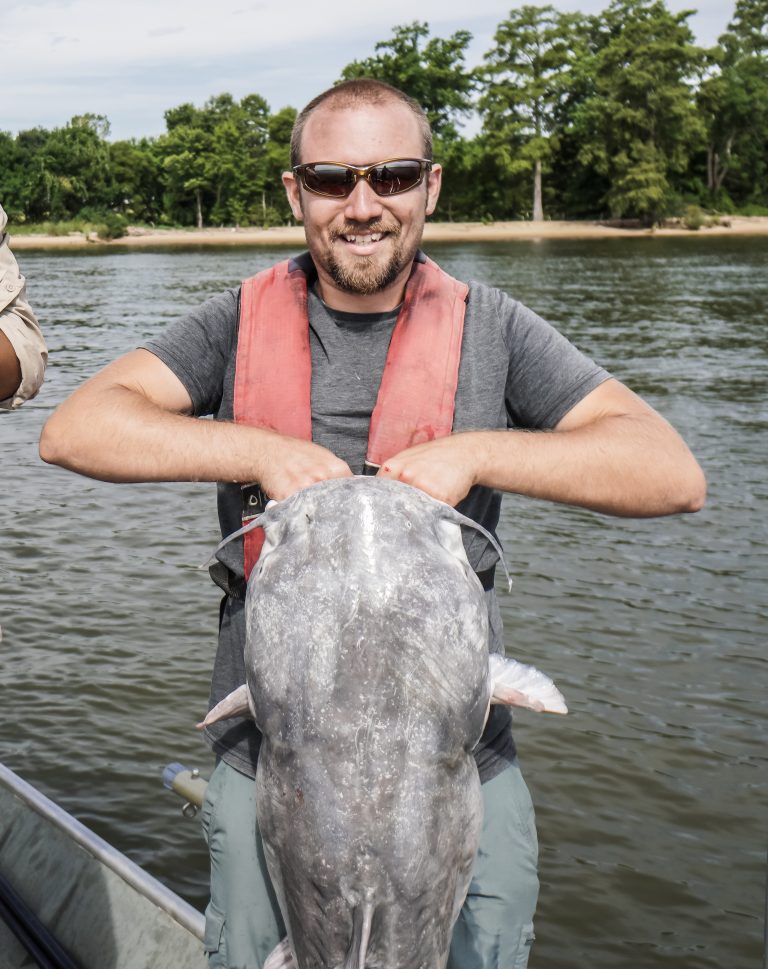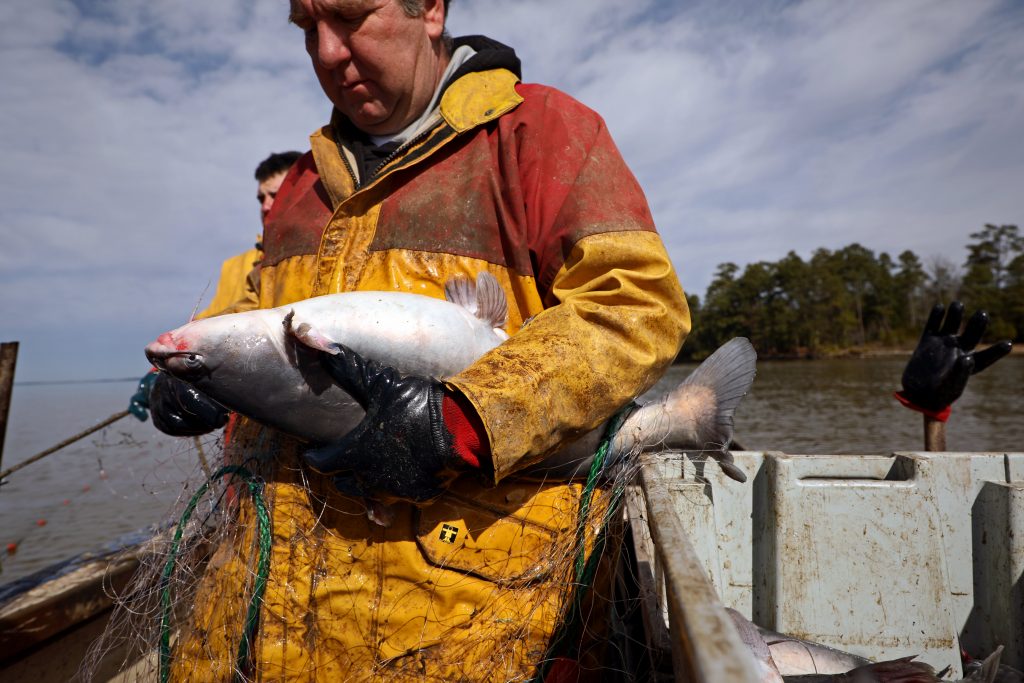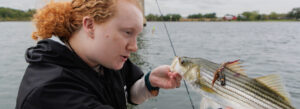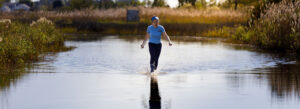New research gives the dish on blue catfish eating habits
Researchers have answered many questions about blue catfish — how many there are in Virginia’s tidal rivers, how fast they’re spreading to new areas, and how fast they’re growing. But one remained unanswered until now: How much do blue catfish eat in a given day?
A new study is the first to estimate food consumption rates for blue catfish in four tidal tributaries of the Chesapeake Bay: The James River, the Mattaponi River, the Pamunkey River, and the Rappahannock River. On average, a blue catfish eats roughly 2-5 percent of its body weight in food in a day during peak feeding season, according to the research published in Transactions of the American Fisheries Society.
“This is the first time we’ve looked at how much blue catfish are eating both in the field and the lab using natural food sources, and for larger fish,” said Joe Schmitt, who led the study of more than 1,200 catfish as part of his Virginia Tech Ph.D. research and Virginia Sea Grant graduate research fellowship.
The researchers also measured how much a blue catfish would eat if they had unlimited food available to them — in this case, blue crab or gizzard shad — and found that the catfish could eat anywhere from 8-9 percent of their body weight in a day. Medium-sized blue catfish consumed more food than the largest blue catfish in the laboratory tanks, although it was unclear whether this eating pattern also holds true out in Virginia’s tidal rivers.
“I think that’s still an open question,” said Donald Orth, a professor in the Virginia Tech Department of Fish and Wildlife Conservation. “Do the fish become more sluggish and feed less when they are adults than they do as smaller fish? We like to think, ‘They’re younger, and they’re just going to be hungrier like a teenager,’ but that’s still hard to demonstrate with the sample size we had.”

“We knew anecdotally that blue catfish eat a lot. You can look at a big one, see its large stomach, and see that this one has hit the buffet line. But this paper has allowed us to put a number on that,” Morgeson said.
While blue catfish aren’t anomalous in how much food they ate, their abundance in Virginia’s rivers means there are more stomachs to fill.

Overall, the average feeding rates for blue catfish were similar to the feeding rates for other non-native species like largemouth bass and channel catfish. While blue catfish aren’t anomalous in how much food they ate, their abundance in Virginia’s rivers means there are more stomachs to fill.
For smaller fish in aquaculture, feeding rates help fish farmers grow their fish to market size — while minimizing the cost of fish food. But for blue catfish in the wild, feeding rates help resource managers like Clint Morgeson understand how blue catfish are affecting other fish in tidal rivers.
“We knew anecdotally that blue catfish eat a lot,” Morgeson, a regional fisheries manager for the Virginia Department of Wildlife Resources said. “You can look at a big one, see its large stomach, and see that this one has hit the buffet line. But this paper has allowed us to put a number on that, and that allows us to draw a line between that number and the impacts that these fish can have on our native species.”
Blue catfish compete with native fish for the food sources available in the river. They eat commercially important species like blue crabs, and also eat native species of concern like American Shad, alewife, and blueback herring.
Now that researchers have shown how much blue catfish eat in a day, these rates can be combined with population estimates — the number of individual blue catfish in a given river — to show how much total food blue catfish are eating in each river. Feeding averages can also be paired with other studies to examine how much blue catfish affect individual species, said Margaret Whitmore, a tidal rivers fisheries biologist for the Virginia Department of Wildlife Resources.
“When you start putting all these pieces together, you get a more holistic picture of the impact of blue catfish on our native species,” Whitmore said. “Consumption rate is a really important step in that process. It really is a gateway to answering a lot of questions down the line.”
Takeaways:
- A new study is the first to estimate feeding rates for blue catfish in four tidal rivers of the Chesapeake Bay.
- On average, a blue catfish eats roughly 2-5 percent of its body weight in food in a day during peak feeding season. This is a similar feeding rate to channel catfish and largemouth bass.
- These blue catfish feeding rates can be combined with diet studies and population studies to estimate how blue catfish are affecting native species in the river — key information for resource managers.
Photos by Aileen Devlin and Ian Vorster | Virginia Sea Grant
Published May 14, 2021.
Schmitt, J.D., Hilling, C.D. and Orth, D.J. (2021), Estimates of Food Consumption Rates for Invasive Blue Catfish. Trans Am Fish Soc. https://doi.org/10.1002/tafs.10300





